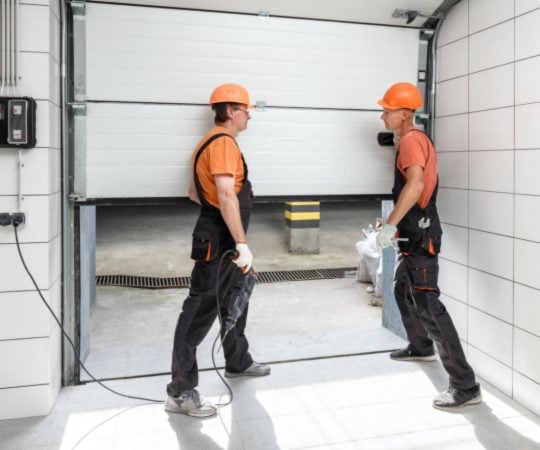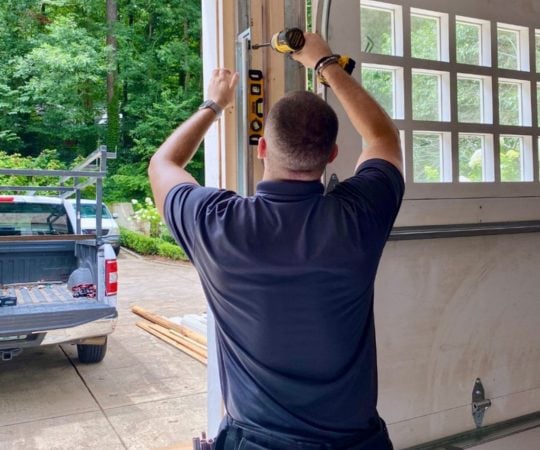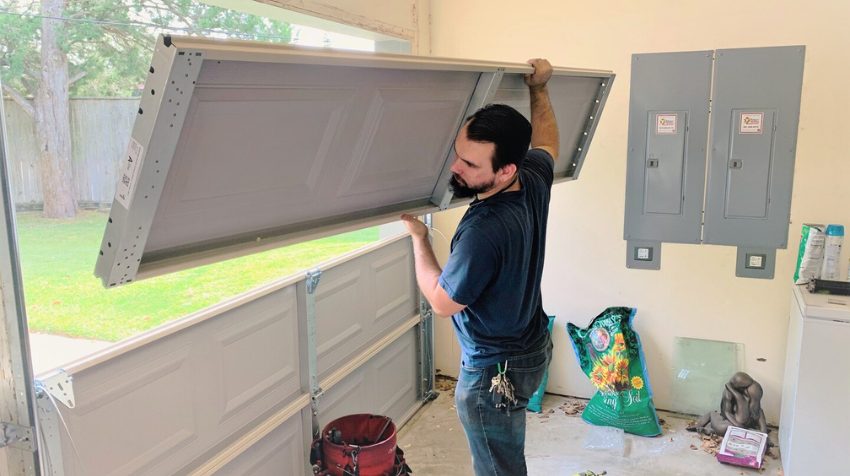Revealing the Path: Effortless Guide to Replacing Your Old Garage Door
Are you tired of your old, squeaky garage door that seems to be on its last leg? Are you constantly worried about the safety and security of your home due to a malfunctioning garage door? Fear not, for replacing your old garage door is easier than you think! In fact, it’s as easy as pie – well, maybe not that easy, but close enough.
With just a little bit of effort and some know-how, you can replace your old garage door effortlessly. If you’re feeling intimidated by the thought of replacing your garage door, don’t worry – you’re not alone. Many homeowners have no idea where to start when it comes to this task.
However, with the right guidance and information at hand, anyone can replace their old garage door with ease. So let’s dive in and unveil the mystery behind how to replace your old garage door like a pro!
Signs that Indicate It’s Time for a New Garage Door
You might be wondering if it’s time to upgrade when you notice strange noises, difficulty opening or closing, and wear and tear on your garage door. It’s important to keep up with regular garage door maintenance to avoid these issues, but even with proper care, a garage door will eventually need replacing. If you’re experiencing any of these signs, it may be time for a new garage door.
Before jumping into purchasing a new one, try some DIY garage door troubleshooting techniques like checking the tracks for debris or tightening loose hardware. However, if these methods don’t solve the problem, it’s best to consult a professional.
Don’t wait until your old garage door completely breaks down – upgrading now can save you from potential safety hazards and costly repairs in the future.
Now let’s explore different types of garage doors that could work for you.
Types of Garage Doors
If you’re considering replacing your garage door, it’s important to understand the different types available.
Sectional garage doors are the most common type. They consist of several panels that slide up and overhead when opened.
Roll-up garage doors are typically used in commercial settings but can also be used in residential garages. They take up minimal space.
Side-hinged garage doors swing open like traditional house doors. They’re a good option for those who want a more traditional look for their garage.
Knowing these key points will help you make an informed decision when choosing a new garage door.

Sectional Garage Doors
Sectional garage doors are a popular choice for homeowners due to their versatility and ease of use. Compared to other types of garage doors, sectional ones have several advantages that make them stand out.
Here are some benefits of sectional garage doors:
- They take up less ceiling space since they open vertically instead of swinging outwards.
- Sectional garage doors come in various sizes and styles, making them perfect for any home design or preference.
- They’re durable and can withstand harsh weather conditions, thanks to their sturdy construction and insulation properties.
- Sectional garage doors require minimal maintenance and repairs compared to other types.
A sectional door might be the perfect fit for your home if you’re looking for a practical, low-maintenance solution. However, if you’re interested in learning about another type of garage door, let’s talk about roll-up garage doors.
Roll-Up Garage Doors
You’ll love the convenience of roll-up garage doors, which are perfect for those who want a low-profile, space-saving option. These types of doors require minimal maintenance and are made from durable materials that can withstand harsh weather conditions. Roll-up garage doors also operate quietly and smoothly, making them an excellent choice for homeowners who value peace and quiet.
One of the advantages of roll-up garage doors is their versatility in terms of design and color options. They come in different sizes to fit any garage opening, and you can choose from various styles that complement your home’s architecture. Whether you prefer a classic or modern look, there’s a roll-up door that will match your preference.
With such flexibility in design and functionality, it’s no wonder why many homeowners opt for this type of garage door.
Moving onto side-hinged garage doors, these types of doors offer a traditional look with easy access to the inside of your garage.
Side-Hinged Garage Doors
The side-hinged garage doors add a touch of tradition to your home, swinging open like welcoming arms. These doors are usually made up of two panels that open outwards, providing easy access for vehicles or people.
One advantage of side-hinged doors is that they offer a wider opening than other types such as roller and sectional garage doors. This means you can park larger vehicles inside with ease.
When it comes to choosing between hinged and sliding doors, there are pros and cons to consider. Side-hinged garage doors require more space in front of the door to swing open compared to sliding ones. However, they offer a more traditional look which may be preferred by some homeowners. Additionally, hinged doors tend to be easier to repair since they have fewer moving parts than sliding ones.
In terms of materials, wood is often the best choice for side-hinged garage doors because it provides both an attractive finish and durability. Ultimately, the decision between hinged and sliding garage doors will come down to personal preference and available space.
Moving on from understanding the difference between hinged and sliding garage doors, let’s take a closer look at how you can choose the right one for your home without breaking a sweat!
Choosing the Right Garage Door for Your Home
When it comes to selecting the perfect garage door for your home, you want to consider a few key factors. First and foremost, think about the style of your house and choose a garage door that complements it.
You also need to consider the material of the door, as this will affect its durability and maintenance requirements. Some popular materials include steel, wood, aluminum, and fiberglass.
In addition to material considerations, there are other design elements to keep in mind when choosing a garage door. For example, you may want windows or decorative hardware added for aesthetic appeal. Insulation is another important factor if you plan on using your garage as a workspace or living space.
By taking all these factors into account, you can select a garage door that not only looks great but functions efficiently as well. Now that you have an idea of what type of garage door you want for your home based on material and design considerations, it’s time to measure your garage opening accurately before making any purchases or installations.
Measuring Your Garage Opening
Before you start measuring your garage opening, make sure you have the right tools on hand. You’ll need a tape measure, level, and step ladder to get accurate measurements.
The measuring process is straightforward, but it requires attention to detail to ensure a proper fit for your new garage door. Be sure to avoid common mistakes, such as not accounting for uneven floors or failing to measure the width at multiple points.
Make sure to take your time with the measurements, and don’t rush through the process. Remember, the more accurate your measurements are, the better your garage door will fit.
Tools You’ll Need
Tools you’ll need:
You’ll want to grab some tools before getting started on this project. Here are the top rated brands for garage door tools that’ll make replacing your old garage door an effortless process:
- DEWALT
- Craftsman
- Chamberlain
Additionally, it’s essential to have proper safety equipment for garage door replacement, such as gloves, safety glasses, and a hard hat. These items can help prevent injuries while working on the project.
Now that you know which tools and equipment to use, it’s time to move onto measuring your garage opening.
Measuring Process
Let’s jump into measuring your garage opening so we can get started on this project! Measuring accuracy is crucial to ensure that your new garage door fits perfectly.
Before you begin, make sure to clear the area around the opening and remove any obstructions. You’ll need a tape measure, level, step ladder, and pencil for this task.
DIY measuring tips include taking measurements in three places: width at the top of the opening, width at the bottom of the opening, and height from the floor to the header. Use your level to make sure that both sides are even and mark each measurement with a pencil. Don’t forget to measure any possible obstructions such as light fixtures or shelves.
Once you have accurate measurements, you can move onto selecting your new garage door. But first, let’s go over some common mistakes to avoid when replacing your old garage door.
Common Mistakes to Avoid
To avoid costly mistakes, make sure to keep in mind some common errors when installing a new garage door. Firstly, don’t underestimate the importance of having the right tools for the job. Attempting to install a garage door without the proper equipment can lead to frustration and ultimately result in an improper installation.
Additionally, not following the manufacturer’s instructions can lead to problems down the line. Make sure you thoroughly understand all aspects of the installation process before beginning.
Another mistake to avoid is failing to properly prepare your garage space for installation day. Clear out any debris or clutter from your garage beforehand so that there is ample room for both you and your installer to work comfortably.
If you have any doubts about whether or not your existing opener system can handle a new door, seek professional help before purchasing anything. By avoiding these common mistakes and following tips for successful garage door replacement, you’ll be well on your way towards enjoying a new and functional addition to your home.
When ordering the correct size door, it’s important to take accurate measurements of both width and height as well as taking into account any obstacles such as pipes or beams that may affect installation.
Ordering the Correct Size Door
Make sure to measure your garage opening accurately to ensure you order the correct size, as 30% of all garage door returns are due to incorrect sizing. Here are some tips to help you get it right:
- Use a tape measure: Measure the width and height of your garage opening in feet and inches. Take three measurements for both width and height, at the top, middle, and bottom of the opening. Use the smallest measurement when ordering your new door.
- Consider headroom and side room: Measure how much space is available above the opening (headroom) and on either side (side room). Different types of doors require different amounts of clearance.
- Check manufacturer guidelines: Each brand has its own recommendations for measuring. Be sure to check their website or contact customer service for specific instructions.
Ordering the correct size door is crucial for a smooth installation process. Once you have your measurements, you can move on to selecting the material and style that best fits your needs before moving onto installing your new garage door.

Installing Your New Garage Door
Installing a new garage door can be an exciting DIY project that adds both functionality and curb appeal to your home. However, it’s important to follow the manufacturer’s instructions carefully to ensure a proper installation.
The first step is assembling the garage door sections, which involves attaching hinges and rollers. Once this is completed, you’ll need to install the tracks on either side of the door frame.
Next, it’s time to install the garage door opener. Make sure you select an opener that’s compatible with your new garage door and follow the manufacturer’s instructions for installation.
You may also want to consider adding some maintenance tips into your installation process. Regularly lubricating all moving parts can help prolong their lifespan and prevent any unnecessary wear or damage over time.
By installing your new garage door correctly and taking care of its maintenance needs, you can enjoy years of trouble-free operation and added value to your home.
Frequently Asked Questions
How much does a new garage door typically cost?
If you’re considering installing a new garage door, it’s important to understand the factors that can affect the overall cost.
First and foremost, the material of your garage door will play a significant role in determining the final price tag. You can choose from options such as aluminum, steel, wood, or composite materials. Each material has its own unique advantages and disadvantages in terms of durability, insulation, and appearance.
Other factors that influence installation costs include the size of your garage door, whether you want windows or insulation installed, and whether there are any structural modifications required for proper installation.
It’s best to consult with a professional installer to get an accurate estimate based on your specific needs and preferences.
Are there any specific safety precautions that need to be taken during the installation process?
Before you start installing your new garage door, it’s important to take some safety measures. First, make sure to read the instructions carefully and follow them step by step.
Wear protective gear such as gloves and goggles to prevent any injuries. It’s also a good idea to have someone else help you with the installation process for extra safety.
When it comes to installation tips, ensure that the garage door is level and properly balanced before attaching it to the opener. Additionally, lubricate all moving parts regularly for smooth operation.
By taking these precautions and following these tips, you can replace your old garage door effortlessly while keeping yourself and others safe in the process.
Can I install a garage door opener with any type of garage door?
Installing a garage door opener is possible with any type of garage door, but it’s important to ensure compatibility between the two. Before buying an opener, check the manufacturer’s specifications to confirm that it’ll work with your specific type of garage door.
When installing the opener, follow these tips for a smooth process: assemble all necessary tools and parts beforehand, read the instructions thoroughly before beginning, and make sure the power source is turned off during installation to avoid electrical shock.
By taking these steps and ensuring compatibility between your door and opener, you can enjoy the convenience and security of an automatic garage door without hassle.
How long does it typically take to install a new garage door?
Installing a new garage door can take anywhere from 4-6 hours, depending on the complexity of the installation process. It’s important to avoid common mistakes such as not measuring correctly or not properly securing the tracks and springs.
Hiring professionals for installation can provide cost benefits in the long run, as they have the expertise and tools necessary to ensure a smooth and efficient installation process. Additionally, professional installers often offer warranties on their workmanship, providing peace of mind for homeowners.
When considering installing a new garage door, it’s important to weigh the time and potential risks of DIY installation versus hiring professionals for a more seamless experience.
Are there any maintenance requirements for a new garage door?
When it comes to garage door maintenance, there are a few things you should keep in mind to ensure the longevity of your new door.
First and foremost, make sure to regularly lubricate all moving parts, such as hinges and springs, to prevent rust and wear.
Additionally, inspect the weatherstripping around the perimeter of the door to ensure it is intact and sealing properly.
It’s also a good idea to periodically check the balance and alignment of your door, as this can affect its overall performance and lifespan.
By staying on top of these simple maintenance tasks, you can help extend the life of your new garage door and avoid costly repairs down the line.
Conclusion
Congratulations! You’ve successfully replaced your old garage door with a brand new one. You can now enjoy the benefits of a better-looking, more secure, and functional door.
Your neighbors will be jealous of your stunning curb appeal, and you’ll feel proud every time you come home to your beautiful garage.
Replacing your garage door may seem like a daunting task, but with our step-by-step guide, it was effortless. Our expert advice gave you all the knowledge and tools needed to choose the right type of door for your home, measure accurately, and install quickly.
Now that everything is done, sit back and admire your work while enjoying the peace of mind that comes with having a safe and reliable garage door.
With such an easy process at hand, it’s no wonder why so many people are thrilled to replace their old garage doors. It’s like getting a facelift for your home without the need for surgery or breaking the bank!
So go ahead and take pride in knowing that you’ve made an excellent investment in both aesthetics and security. Cheers to many years of worry-free use ahead!
Related Source

